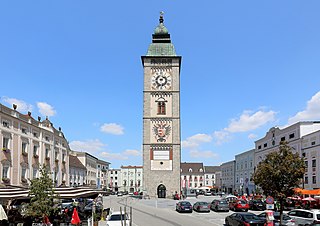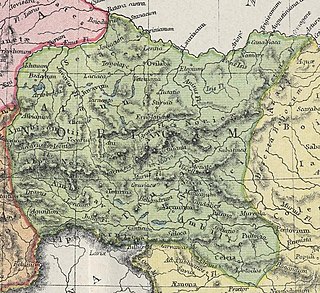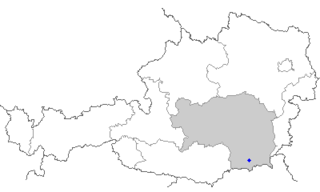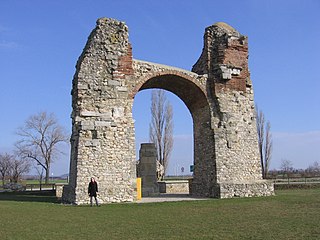
The Marcomanni were a Germanic people that established a powerful kingdom north of the Danube, somewhere near modern Bohemia, during the peak of power of the nearby Roman Empire. According to Tacitus and Strabo, they were Suebian.

The history of Styria concerns the region roughly corresponding to the modern Austrian state of Styria and the Slovene region of Styria (Štajerska) from its settlement by Germans and Slavs in the Dark Ages until the present. This mountainous and scenic region, which became a centre for mountaineering in the 19th century, is often called the "Green March", because half of the area is covered with forests and one quarter with meadows, grasslands, vineyards and orchards. Styria is also rich in minerals, soft coal and iron, which has been mined at Erzberg since the time of the Romans. The Slovene Hills is a famous wine-producing district, stretching between Slovenia and Austria. Styria was for long the most densely populated and productive mountain region in Europe.

Noricum is the Latin name for the kingdom or federation of tribes that included most of modern Austria and part of Slovenia. In the first century AD, it became a province of the Roman Empire. Its borders were the Danube to the north, Raetia and Vindelici to the west, Pannonia to the east and south-east, and Italia to the south. The kingdom was founded around 400 BC, and had its capital at the royal residence at Virunum on the Magdalensberg.

Aquileia is an ancient Roman city in Italy, at the head of the Adriatic at the edge of the lagoons, about 10 kilometres (6 mi) from the sea, on the river Natiso, the course of which has changed somewhat since Roman times. Today, the city is small, but it was large and prominent in classical antiquity as one of the world's largest cities with a population of 100,000 in the 2nd century AD and is one of the main archaeological sites of northern Italy. In late antiquity the city was the first city in the Italian Peninsula to be sacked by Attila the Hun.
Leibnitz is a city in the Austrian state of Styria and on 1 Jan. 2023 had a population of 13,014. It is located to the south of the city of Graz, between the Mur and Sulm rivers.

The Mur or Mura is a river in Central Europe rising in the Hohe Tauern national park of the Central Eastern Alps in Austria with its source at 1,898 m (6,227 ft) above sea level. It is a tributary of the Drava and subsequently the Danube.

Enns is a town in the Austrian state of Upper Austria on the river Enns, which forms the border with the state of Lower Austria.

Noreia is an ancient lost city in the Eastern Alps, most likely in southern Austria. While according to Julius Caesar it is known to have been the capital of the Celtic kingdom of Noricum, it was already referred to as a lost city by Pliny the Elder. The location of Noreia has not been verified by modern researchers.
Magdalensberg is a market town in the district of Klagenfurt-Land in Carinthia in Austria.
Gleinstätten is a market community in southern Austria which had 4,232 inhabitants in 2019.

The Sulm is a river in Southern Styria, Austria. It is 29.3 km (18.2 mi) long. Its drainage basin is 1,121 km2 (433 sq mi). Its two source rivers Schwarze and Weiße Sulm both originate at the eastern slopes of the Koralpe. It flows eastwards towards the Mur through the districts of Deutschlandsberg and Leibnitz. The Sulm valley runs from the Western Styrian hill ranges to the Eastern Styrian hills and lowlands.

The Sausal is a small mountain range in the southwestern parts of Austria's state Styria. It thrusts up from the northern banks of the Sulm valley, west of the district town of Leibnitz. Its highest point, the summit of the Demmerkogel, rises 671 m above the level of the Adriatic Sea. Large parts of the Sausal have a mediterranean-type microclimate. Together with the rich soil this is the basis of its extensive vineyards, which are the cornerstone of the local economy. Tourism flourishes as well.

Kitzeck is the central settlement in the Sausal mountain range in Southern Styria, Austria. It is the highest-altitude wine-growing community in Austria.

The Universalmuseum Joanneum is a multidisciplinary museum with buildings in several locations in the province of Styria, Austria. It has galleries and collections in many subject areas including archaeology, geology, paleontology, mineralogy, botany, zoology, history, art and folk culture. It is the oldest museum in Austria as well as the largest universal museum in central Europe with over 4.5 million objects in 13 departments and 12 locations in the Styrian cities of Graz, Stainz, Trautenfels, and Wagna. To reflect this status and its growth over the last two centuries, as well as to present a more recognizable image internationally, the Landesmuseum Joanneum was officially renamed to Universalmuseum Joanneum on 10 September 2009.
The Latobici or Latovici were a Celtic tribe dwelling in Pannonia Superior, around present-day Drnovo (Slovenia), during the Roman period.

Claudium Virunum was a Roman city in the province of Noricum, on today's Zollfeld in the Austrian State of Carinthia. Virunum may also have been the name of the older Celtic-Roman settlement on the hilltop of Magdalensberg nearby. Virunum (Virunensis) is today a Catholic titular see.
Richard Knabl was an Austrian parish priest and epigraphist who, though he lacked formal academic training as a historian, became a prominent contributor to our current knowledge of the Roman period in Noricum and western Pannonia, especially on the territory of modern Styria.

The Pannonian Limes is part of the old Roman fortified frontier known as the Danubian Limes that runs for approximately 420 km (260 mi) from the Roman camp of Klosterneuburg in the Vienna Basin in Austria to the castrum in Singidunum (Belgrade) in present-day Serbia. The garrisons of these camps protected the Pannonian provinces against attacks from the north from the time of Augustus (31 BC–14 AD) to the beginning of the 5th century. In places this section of the Roman limes also crossed the river into the territory of the barbarians (Barbaricum).

Erna Diez was an Austrian classical archaeologist who undertook significant work on Roman art and the archaeology of the provinces of Noricum and Pannonia.
The gens Secundinia was a minor plebeian family at ancient Rome. No members of this gens are mentioned by ancient writers, but a number are known from inscriptions, dating entirely or almost entirely from imperial times, and concentrated in Gaul, Germania, Noricum, and adjacent areas.

















